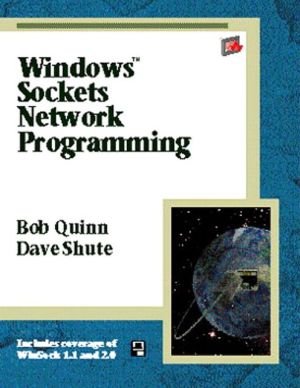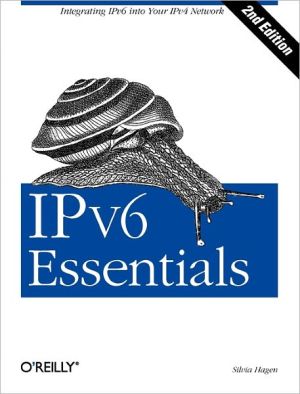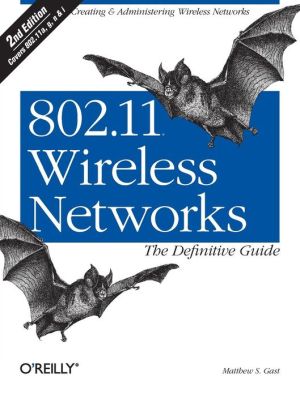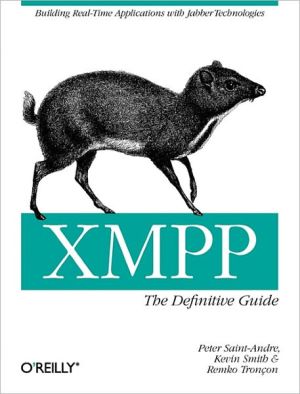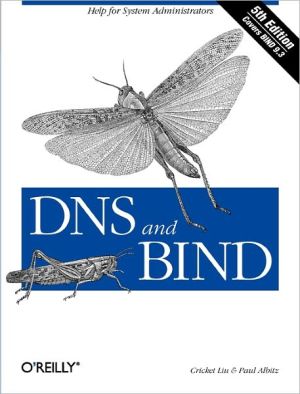Windows Sockets Network Programming (paperback)
Windows Sockets (WinSock), a standard network API co-developed by PC network industry leaders including Microsoft, Novell, Hewlett-Packard, and FTP Software, is an extraordinary resource for Windows network programmers. This book will enable you to reap WinSock's full benefits to create client and server network applications for use on any TCP/IP network, including the Internet. It also lays the groundwork for WinSock application development using other protocol suites.\ The book describes...
Search in google:
Windows Sockets (WinSock), a standard network API co-developed by PC network industry leaders including Microsoft, Novell, Hewlett-Packard, and FTP Software, is an extraordinary resource for Windows network programmers. This book will enable you to reap WinSock's full benefits to create client and server network applications for use on any TCP/IP network, including the Internet. It also lays the groundwork for WinSock application development using other protocol suites.The book describes how to develop 16- and 32-bit WinSock applications, and focuses on designs that will run on any WinSock implementation. It highlights the differences that exist between WinSock DLLs, and other traps and pitfalls in network application development, and shows you how to avoid them. It covers every function in version 1.1 of the WinSock specification, and provides a detailed tour of the newest features in WinSock version 2.Windows Sockets Network Programming is geared for novice and experienced network programmers alike. The early chapters provide a tutorial that brings novices up to speed quickly, and the remainder provides a detailed reference, with examples. These include complete source code for a number of useful applications, including an ftp client. Other topics covered include: how to create a dynamic link library to run over WinSock, how to port existing BSD Sockets source code to WinSock, and how/when to use WinSock's optional features. It also details debugging techniques and tools.The appendices provide a quick reference for API essentials, illustrations of the TCP/IP protocol suite, an extensive error reference, and pointers to more information on or off the Internet. The accompanying disk contains the source code for all the sample applications, as well as a few other tools to help you with your programming tasks. Booknews A book/disk package describing how to use WinSock to create client and server network applications for use on any TCP/IP network. Describes how to develop 16- and 32-bit WinSock applications, highlights the differences between WinSock DLLs, and provides a detailed tour of the newest features of WinSock version 2. The first half of the book is a tutorial for novice programmers, while the rest offers examples and source code for various applications. The disk contains source code and programming tools. For beginning and experienced programmers. Annotation c. Book News, Inc., Portland, OR (booknews.com)
PREFACE: This book describes the Windows Sockets application programming interface (API), commonly known as "WinSock." This is intended to be a companion to the v1.1 Windows Sockets specification, not a replacement for it. The contents provide a roadmap for the specification, an orientation resource. The book describes and illustrates every aspect of the Windows Sockets specification, from top to bottom. It deals with optional features as well as many features in version 2.0 of the Windows Sockets specification.\ The key focus of the text is to provide a "how to" guide for writing supportable and extensible network applications that will run efficiently over all Windows Sockets implementations. One of the most frustrating things to hear is, "It's impossible to write anything more than a basic 'hello world' that will execute over all Winsock implementations." This simply is not true. More often than not, when an application runs on one WinSock and fails on another, it is because the application developers made some incorrect assumptions. They assumed that WinSock could do something that the specification did not explicitly warrant. In other words, it may not have been the fault of the WinSock implementor, nor of the WinSock specification. You can avoid this type of application failure, and we show you how.\ This book is for anyone who wants to know how to write a successful WinSock application. If you are writing a program from scratch, porting an existing one from Berkeley sockets (or any other network API), writing a network DLL, or just updating an application that someone else wrote, then this book is for you. We deal with both 16-bit Windows platforms (Microsoft Windows 3.1and Windows for Workgroups) and 32-bit platforms (Windows NT 3.1 and 3.5, and Windows 95). We also describe the other platforms that support the WinSock API: Platforms with Windows are adding Sockets.\ Organization\ The first half of the book contains a tutorial for network programming. We do not make any assumptions about what you already know. The second half is intended to be an in-depth reference, with detailed explanations and code examples. The appendices provide a quick reference.\ After we describe Windows Sockets in general terms in Chapter 1, we provide an overview of network software architectures in Chapter 2. In Chapter 3 we describe the protocols in the TCP/IP suite, with a focus on the services available to your network applications, and some of their pros and cons. We begin to provide some details about the WinSock programming interface in Chapter 4, as we describe the framework for all network applications in terms of the fundamental network function calls. Chapter 5 covers the different operation modes available, and Chapter 6 discusses the state machine implicit in every network application. That essentially ends the tutorial.\ In Chapter 7 we present the source code for our largest application, an FTP client. Chapters 8, 9, and 10 are a catalog of detailed descriptions of all the WinSock function calls we have not discussed up to this point. Chapter 11 deals with the specifics of creating a dynamic link library to run over a WinSock DLL. Chapter 12 describes the issues and strategies involved with porting existing BSD Sockets source code to 16-bit and/or 32-bit Windows.\ We start to wrap things up and tie up loose ends in Chapter 13, which details WinSock application debugging techniques and tools. Chapter 14 provides general advice and many specifics about traps and pitfalls to avoid in your WinSock applications. Chapter 15 describes the many different operating-system platforms that currently provide the WinSock API. Chapter 16 covers the optional features - some intentional, and some not - in the WinSock specification and tells you when and how to use them. Finally, Chapter 17 provides a detailed tour of all the new features in version 2.0 of the WinSock specification.\ In Appendix A, we have illustrations and short descriptions of the headers for protocols in the Internet suite (TCP/IP). Appendix B contains a quick reference for the entire WinSock API, including its functions, structures, and macros (including some that were forgotten). Appendix C provides a detailed WinSock error reference. Appendix D contains some mechanical details for compiling and linking applications, and Appendix E has network and bibliographical information sources.\ Audience\ Although we do not assume any prior knowledge of networks, protocols, or network programming with sockets or any other network API, it does not hurt to have some. This book is for novice and experienced network application developers alike. This text also includes extensive background and illustrative information not found in the v1.1 Windows Sockets specification, so even the most advanced WinSock application developer can benefit from reading it.\ We do assume a knowledge of the C programming language and Microsoft Windows APIs (WinAPI or Win32).\ Sample Applications\ The sample applications in this book were created with Microsoft C version 1.51 (16-bit) and Microsoft C version 2.0 (32-bit). They are also compatible with Borland C version 4.0. Makefiles that support these platforms accompany the source code. The applications have been tested on almost all of the commercial and shareware versions of WinSock available, over Ethernet and PPP (point-to-point protocol), using both local and distant connections. If you find any problems with these applications, we'd like to hear about them. Please e-mail problem reports to bugs@sockets.com.\ You can retrieve updates to these sample applications via the Internet: ...
ForewordPrefaceCh. 1Introduction to Windows Sockets1Ch. 2Windows Sockets Concepts11Ch. 3TCP/IP Protocol Services31Ch. 4Network Application Mechanics47Ch. 5Operation Modes75Ch. 6Socket States121Ch. 7Sample Application and Library177Ch. 8Host Names and Addresses257Ch. 9Socket Information and Control285Ch. 10Support Routines319Ch. 11DLLs over WinSock353Ch. 12Porting from BSD Sockets385Ch. 13Debugging405Ch. 14Dos and Don'ts427Ch. 15Platforms459Ch. 16Optional Features471Ch. 17WinSock 2495Appendix A: TCP/IP Protocol Headers521Appendix B: Quick Reference539Appendix C: Error Reference565Appendix D: What You Need599Appendix E: Information Sources605Index621
\ BooknewsA book/disk package describing how to use WinSock to create client and server network applications for use on any TCP/IP network. Describes how to develop 16- and 32-bit WinSock applications, highlights the differences between WinSock DLLs, and provides a detailed tour of the newest features of WinSock version 2. The first half of the book is a tutorial for novice programmers, while the rest offers examples and source code for various applications. The disk contains source code and programming tools. For beginning and experienced programmers. Annotation c. Book News, Inc., Portland, OR (booknews.com)\ \
